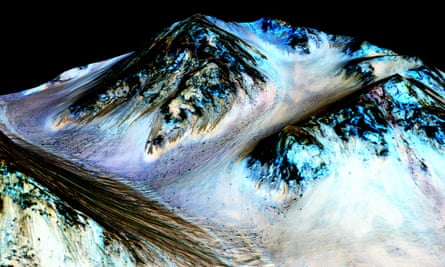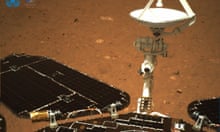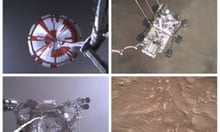This week Nasa announced it had found evidence of liquid water on the surface of Mars. The space agency said the “dark streaks” on the walls of the Garni crater were proof of flowing water on the planet, evidence that a habitable environment was “at least possible”; and they might show them the most likely sites for finding life on Mars.
This was huge news, prompting headlines around the world and excitable, scientifically undereducated types like myself to believe the first interplanetary BBQ with our new friends was just decades away.
Monday’s announcement, while dramatic, is not the first time we’ve been given reason to hope that Mars is wet and inhabited. Nasa has found evidence of water on Mars plenty of times – frozen water at the poles, water under the surface, old riverbeds, ancient lakes, even evidence of a large ocean covering the northern hemisphere. Last year, there was a flurry when spikes of methane were detected on Martian meteorites, potentially indicating that colonies of microbes were living there. This discovery caused newspapers around the world to declare that life – or in the cases of the more cautious papers: “life” or life? – had been found on Mars.

These discoveries have raised questions that non-scientists rarely have to think about: what constitutes proof of life on another planet? Assuming an alien isn’t about to streak in front of a Mars rover, which if we’re honest is what we’re all secretly hoping for, what do you look for? And how do you find and send back evidence of life to Earth without contaminating that evidence with life – microbes, bacteria etc – that you’ve brought from Earth?
It seems David Bowie’s question does not go far enough. Is there life on Mars, and if so, how do we prove it?
Adjust your expectations
We’ve been fed on a televisual diet of little green men, of humanoid aliens we can fight if they’re evil or rescue and befriend if they’re not.
Which is why even the most reasonable among us get a little frisson when we see extremely spurious photographs of supposed life on Mars. Could this skeleton of an alien be real? Wouldn’t it be great if it were? We know that probably the first life that’s found on Mars will be single-celled and only visible under a microscope, but is it so crazy to wish that instead of that we could have the Martian Crabzilla? Or even just a sneaky Mars rat? I mean, that would be awesome right?
Sadly, this is apparently very far from the type of life we might find on Mars today. As Nasa scientist Ashwin Vasavada told CNN last year in a tone of someone trying hard to take a ridiculous question seriously (a tone I imagine he has to adopt often): “We have no evidence of Martian iguanas or rats at this time.” Dammit.

The sort of life that space scientists are hoping to find doesn’t shoot lasers, or speak an odd language; in fact, it doesn’t really do anything. They’re looking for microbes, the single-celled organisms so tiny that millions could fit inside the eye of a needle.
How would you “prove” microbial life?
Once you’re over the disappointment of the fact we’re looking for microbes rather than colonies of scaly green puppies, you’re still left with a tricky problem. Microbial life, unassuming as it is, is still quite difficult to prove.
In 1996, scientists at the Johnson Space Center in Houston, Texas, believed that they had found a rock from Mars which contained “microfossils” – that is, fossils caused by ancient Martian microbes.
However, a British scientist came along to rain on their parade when he discovered that bacteria from Earth had contaminated the Mars rock, sneaking their way in through cracks in the rock. He claimed his work didn’t prove there were no Martian fossils in the rock, but he did raise the question of how anyone could really be sure. Who could tell when microbes were genuinely Martian, or simply earthly contaminants?
The problem of contamination
This is a pressing problem for Nasa in light of this week’s announcement. The “dark streaks” of flowing water could act as a big X on a map, telling scientists where to dig if they want to find microbial treasure, but now what do they do?
The Curiosity rover could just trundle over to the streaks of water that have been found – though they are on a slope, which the rover may not be able to handle – and dig up some dirt for analysis. But the rover isn’t sterile and so is not allowed to visit protected regions of Mars, lest it bring with it any bugs from Earth that might contaminate the area and bugger up the most-likely potential eco-system outside our planet. So, the preliminary answer to the question how do you prove there’s life on Mars is: very, very carefully.

The actual scientific answer to how you prove life on Mars
In 2018, the ExoMars rover will launch out of the Earth’s atmosphere on its mission to Mars. This rover will be able to drill two metres below the surface of the planet and may be our best bet so far of finding proof of life on the planet.
The ExoMars rover will be able to bring up samples in a powdered form, heat them to very high temperatures and allow them to be analysed in a mass spectrometer, which, according to Professor Andrew Coates of the Mullard Space Science Laboratory, University College London, who is involved in the mission, is crucial if scientists are going to confirm life on the planet.
Coates says the proof will come from a “combination of things: are there bio-markers, chirality, the beginnings of amino acids, that sort of thing. If you saw something that looked like a fossil that would be good, but unlikely because of the difficulty of doing the imaging.”

Coates said that “getting an image would be the ultimate proof”, but would be proof only if it was supported by “a buildup of evidence – geological, isotopic evidence”.
It seems there is no holy grail of proof agreed upon by all scientists that would automatically qualify as evidence of life on Mars, but rather there’s heated discussion.
“For example, with the Viking results [results of a Nasa mission in the 1970s, in which Martian soil was mixed with a drop of nutrient-rich water to see how it reacted] there were discussions of do they show evidence of life or not. The scientific community in general decided it didn’t. It’s the case of convincing peers in the field with the right expertise,” said Coates.
But what if life isn’t as we know it...
This all sounds very reasonable and peer-reviewable, but there is a question hanging eerily in the air. Scientists are looking for life by all the bio-markers and bio-signatures that compute with our terrestrial existence, but what if life on Mars is not life as we know it? What if the life there isn’t carbon-based and doesn’t emit methane like we do? Could “they” be out there – incandescent mists of sentient atoms, unable to be touched or seen or heard, watching us as our rovers dig up their planet and chuckling?
Probably not. Probably all we can hope for is microbes, but then again...











Comments (…)
Sign in or create your Guardian account to join the discussion